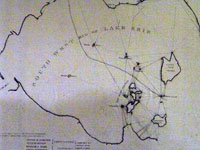TICKETS ARE STILL AVAILABLE FOR THE 2024 SPRINGSONG BANQUET @ PELEE ISLAND WINE PAVILION!!
“Research. Collect. Preserve.”  The Pelee Island Heritage Centre aspires to research, collect and preserve the evidence of the Island’s (and neighbours’) human history, to protect the community’s natural heritage, and to educate the public about our combined heritage through exhibits, publications, special presentations and our extended stay education program. It is understood, moreover, that the Heritage Centre, through the benefit of hindsight, should play a role in informing current community planning issues.
The Pelee Island Heritage Centre aspires to research, collect and preserve the evidence of the Island’s (and neighbours’) human history, to protect the community’s natural heritage, and to educate the public about our combined heritage through exhibits, publications, special presentations and our extended stay education program. It is understood, moreover, that the Heritage Centre, through the benefit of hindsight, should play a role in informing current community planning issues.
An Introduction to Pelee Island: Nothing Like It
Where can you go in Canada to see Prickly Pear Cactus, fields of vineyards, a Blue Racer, 20,000 pheasants, native Coffee Trees, a 170 year old lighthouse, flat alvar landscapes, and buildings that whisper the history or an era of hand-quarried limestone, steamships, iceboats, saw mills and pump houses? One place. One Island. Pelee Island Canada South, the southernmost territory or Canada, is comprised of a number of islands which form an archipelago in the Western Basin of Lake Erie, Pelee Island and Middle Island are situated just above the Canadian-American border, between latitude 41 degrees, 45 minutes, and 41 degrees, 41 minutes. The climate on these islands boasts the highest heat units in the country, and the longest frost free season in Ontario. Along with the aforementioned differences, are many others, the foremost being the condition of isolation. To this place apart settlers came to make a living, one defined by difficulty in perseverance. A community evolve, one that reflected the setting, in social and in economic ways, but importantly, too, in habit of thought.  A dozen and more factors made the islands a place of wildlife diversity; they became home to a myriad of species rare to Canada. Almost one third of the vascular plant diversity of all of Ontario is represented on Middle and Pelee Islands. Carolinian Canada at its richest is found here. Rare insects, snails, mammals, birds, reptiles and amphibians came to comprise a neighborhood of outstanding natural heritage. And many are the reasons for their presence. For a considerable period after glaciation the Western Basin was largely dry, with what we term “Lake Erie” commencing to the East. The islands were not islands, but uplands in the midst of a causeway that allowed the colonization of plants and animals from the South. The process of glaciation had left a variety of habitats for wildlife; wetlands, sand dunes, alvars (areas of limestone with shallow overburden), and deep soils suitable for the trees of the Eastern Deciduous Forest zone. And the Western Basin was left shallow, by virtue of the resistant bed of limestone which covers the western extreme of Lake Erie. The shallow waters reach relatively high temperatures in the summer months, giving the islands a climate suited for more southern locations.
A dozen and more factors made the islands a place of wildlife diversity; they became home to a myriad of species rare to Canada. Almost one third of the vascular plant diversity of all of Ontario is represented on Middle and Pelee Islands. Carolinian Canada at its richest is found here. Rare insects, snails, mammals, birds, reptiles and amphibians came to comprise a neighborhood of outstanding natural heritage. And many are the reasons for their presence. For a considerable period after glaciation the Western Basin was largely dry, with what we term “Lake Erie” commencing to the East. The islands were not islands, but uplands in the midst of a causeway that allowed the colonization of plants and animals from the South. The process of glaciation had left a variety of habitats for wildlife; wetlands, sand dunes, alvars (areas of limestone with shallow overburden), and deep soils suitable for the trees of the Eastern Deciduous Forest zone. And the Western Basin was left shallow, by virtue of the resistant bed of limestone which covers the western extreme of Lake Erie. The shallow waters reach relatively high temperatures in the summer months, giving the islands a climate suited for more southern locations.
 |
 |
 |
EventsSee what big events we have coming in 2016! |
DonationsHelp us preserve Pelee Island and its great history. |
Find Us!Click here to find us on a map. |
| Read more… | Read more… | Read more… |
